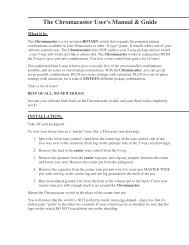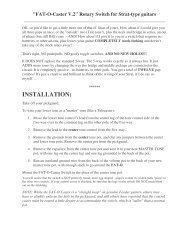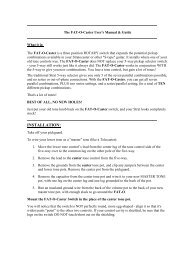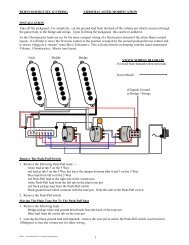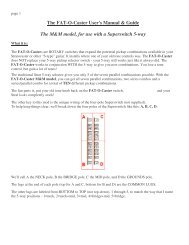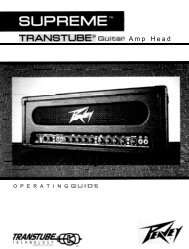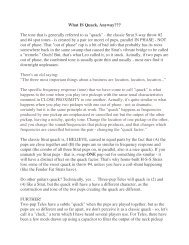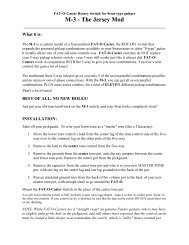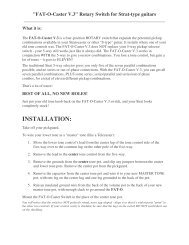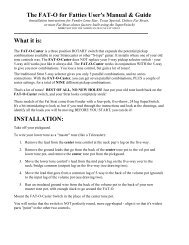3-ways and 5-ways - Deaf Eddie
3-ways and 5-ways - Deaf Eddie
3-ways and 5-ways - Deaf Eddie
Create successful ePaper yourself
Turn your PDF publications into a flip-book with our unique Google optimized e-Paper software.
Lever-style Pickup Selectors<br />
The lever-style pup selectors as used by Fender (<strong>and</strong> others) are actually two-pole<br />
switches. If you look at the STOCK switch, it has two rows of lugs - each row is<br />
considered a pole. So, when you work the lever, you are actually throwing TWO switches<br />
at once.<br />
Look at the first two switches in this drawing (for now, ignore the second two switches):<br />
I've labeled the lugs to reference which position would be selected (Bridge, Middle,<br />
Neck) OR to show that they are the Common lug - that's the unchanging lug that the<br />
other lugs are switched between.<br />
As you work the lever you are moving a wiper, which comes in contact with (or loses<br />
contact with) the three switchable lugs. The common lug is ALWAYS in contact with the<br />
wiper.<br />
A Tele scheme is pretty straight ahead - three throws on the switch, three different tones.<br />
This is achieved by using one pole (one side) of the switch to select the bridge pup, <strong>and</strong><br />
the other side of the switch to select the neck pickup. There are actually two <strong>ways</strong> to do<br />
this - you can have the pups connected to the commons, or the output connected to the<br />
commons...
In this drawing, the pickups are wired to the commons, <strong>and</strong> the switchable lugs are<br />
jumpered together <strong>and</strong> on to the output:<br />
You can see that the neck pup is connected to the output in two throws; the bridge pup is<br />
connected in two throws.<br />
NEXT:<br />
Here's a Strat, where they use one pole (one side) to select the pickups, <strong>and</strong> one pole to<br />
select the tone pots:<br />
On a Strat, the COMMONS are connected <strong>and</strong> routed to the volume pot. Because the<br />
commons are jumpered together, when the neck pup is selected, the neck tone pot is also<br />
in the circuit. The same goes for the middle pup.<br />
Remember, when this switch was first used, Strats also only had THREE throws, <strong>and</strong> Leo<br />
used the same switch in Strats <strong>and</strong> Teles.
SOME HISTORY:<br />
The #2 <strong>and</strong> #4 throws (where the Strat's "quack" is) came about because players<br />
discovered that because of the way that original 3-way selector was designed ("make<br />
before break" style), if you carefully got the lever to stick in the "in-between" spot. I'm<br />
sure Leo selected this particular switch to eliminate possible "popping" sounds when<br />
switching between pickups. In between the original #1 <strong>and</strong> #2, (<strong>and</strong> #2 <strong>and</strong> #3), the<br />
switch's wiper would actually make contact with the next lug BEFORE it lost contact<br />
with the previous lug - so you heard TWO pickups on your Strat at once!<br />
Some Strat player figured that little trick out, fiddled with the switch until he got it to<br />
play two pups at once, finding the QUACK - <strong>and</strong> the rest is history. It was a happy<br />
accident, but it was flat amazing!<br />
All they had to do was to add two mechanical "stops" to the 3-way switch, so that it<br />
would stay at the "touching-two-lugs" point in its travel. There's no difference in the lug<br />
layout of the st<strong>and</strong>ard 3-way <strong>and</strong> 5-way, it's just a matter of how we wire them up.<br />
After a third-party began marketing these 5-throw/3-way switches with two extra "stops"<br />
at throws #2 <strong>and</strong> #4 (as I recall, late sixties, early seventies), Fender finally made the 5-<br />
way selector switch stock on Strats (mid-seventies, if memory serves). The wiring didn't<br />
change, just the switch, <strong>and</strong> only slightly - two new "notches" were made in the<br />
mechanical action of the switch, so that it would consistently stop while contacting two<br />
of the lugs - so we could all get the magic "in-between" tones.<br />
******<br />
The other two switches in the first drawing are examples of other 5-<strong>ways</strong>. They still have<br />
two poles, but the poles are in-line <strong>and</strong> one after the other. Can you see them?
Here's a drawing I’ve done that might enlighten - a side view of a 3-way/5-way:<br />
This is ONE POLE, remember - it's repeated in mirror image on the other side of the<br />
switch. You can see that the common lug is al<strong>ways</strong> in contact with the wiper, <strong>and</strong> the<br />
contact point on the wiper moves across the switchable lugs as you work the lever.<br />
******<br />
You have to fully grasp the concept that your 3-way (or 5-way) is really TWO separatebut-parallel-<strong>and</strong>-synchronized<br />
switches.<br />
In Strats <strong>and</strong> Teles, the jumpers between the two poles (wires that cross over) are<br />
simply to connect the results of those TWO separate switches. It is then sent on to<br />
the volume pot.<br />
In the case of the stock Strat, with the two COMMONS jumpered together, it's because<br />
one pole runs the pickup selection, <strong>and</strong> the other pole runs the tone control selection.<br />
Now, they could have just connected both commons separately to the volume pot - yes,<br />
they could have run two wires meeting at the volume pot, using NO JUMPERS - <strong>and</strong><br />
achieved the same thing.<br />
Jumpering them together across the switch is just a "shortcut" to have both the tone-potsside<br />
of the switch <strong>and</strong> the pickups-side of the switch connected to the volume pot with the<br />
minimum amount of wire.<br />
They don't really HAVE to have any lugs jumpered together, there's no circuitry magic -<br />
it's just a wiring shortcut.
On a Tele, they used BOTH poles for pickup selection - one pole runs the bridge pup, <strong>and</strong><br />
one pole runs the neck pup. Adjacent switchable poles are jumpered together because<br />
each of the two Tele pups is "on" in two of the three throws - so you gotta have two lugs<br />
out of three connected for each pup.<br />
The jumper wire that runs across the switch is, again, just a wiring shortcut. They could<br />
have run a separate wire from the bridge side of the switch to the volume pot, <strong>and</strong> run<br />
another wire from the neck side of the switch to the volume pot - but, hey, since we're all<br />
going to the same place, why not "hook up <strong>and</strong> share the ride?"<br />
It's not magic, it's not mysterious electronic wizardry, it's just logical wiring shortcuts.<br />
Leo was nothing if not thrifty <strong>and</strong> efficient!



